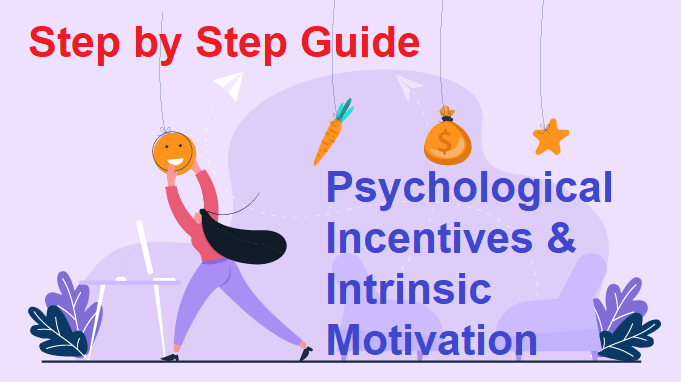Step-by-Step Guide to Implementing Psychological Incentives and Intrinsic Motivation to improve Work Performance

#TalentManagement
Step 1: Understand Psychological Incentives and Intrinsic Motivation
Psychological Incentives are non-monetary rewards that can boost an employee’s motivation and engagement. They often appeal to employees’ intrinsic motivations, which are driven by internal satisfaction rather than external rewards.
Psychological Incentives
- Gamification: Introduce game-like elements such as points, badges, and leaderboards to make work tasks more engaging and fun.
- Recognition Programs: Create recognition programs that celebrate achievements and milestones.
Intrinsic Motivation
Intrinsic Motivation is the internal drive to perform a task for its inherent satisfaction rather than for some separable consequence. It is often fueled by factors such as autonomy, mastery, and purpose.
Step 2: Identify Key Areas for Improvement
- Conduct surveys or interviews to understand what motivates your employees.
- Identify areas where employees feel disengaged or demotivated.
Step 3: Set Clear and Achievable Goals
Format Example: SMART Goals Template
| Specific | Measurable | Achievable | Relevant | Time-bound |
| Clearly define the task or objective | Set criteria to measure progress | Ensure the goal is realistic | Align with overall company goals | Set a deadline for completion |
Step 4: Implement Psychological Incentives
Techniques and Tools
- Recognition Programs:
- Tool: Employee of the Month Awards, Digital Badges
- Format Example: Recognition Template
| Employee Name | Achievement | Recognition Date | Reward |
| Jane Doe | Exceeded sales targets | July 2024 | Certificate and public acknowledgment |
- Research Finding: According to Gallup, employees who receive regular recognition and praise increase their productivity, receive higher loyalty and satisfaction scores from customers, and are more likely to stay with their organization.
- Gamification:
- Tool: Points Systems, Leaderboards
- Format Example: Gamification Scoreboard
| Employee Name | Task Completed | Points Earned | Total Points |
| John Smith | Completed training module | 10 | 50 |
- esearch Finding: Research published in the Journal of Applied Psychology indicates that gamification can lead to a significant increase in employee engagement and motivation .
- Personalized Feedback:
- Tool: Feedback Software, One-on-One Meetings
- Format Example: Feedback Form
| Date | Employee Name | Feedback | Action Plan |
| 20-Jul-2024 | John Smith | Great job on the project, consider improving on time management. | Set a timer for tasks. |
- Team Building Activities:
- Tool: Outings, Workshops
- Format Example: Team Building Schedule
| Activity | Date | Location | Objective |
| Escape Room | 30-Jul-2024 | Offsite Venue | Improve collaboration |
Step 5: Foster Intrinsic Motivation
Techniques and Tools
- Autonomy:
- Tool: Flexible Work Hours, Remote Work Options
- Format Example: Flex Work Agreement
| Employee Name | Flex Hours | Remote Days | Review Date |
| Jane Doe | 10am-6pm | Wednesdays | 01-Aug-2024 |
- Research Finding: A study in the Journal of Organizational Behavior shows that employees who have higher job autonomy experience greater job satisfaction and motivation .
- Mastery:
- Tool: Professional Development Programs, Workshops
- Format Example: Development Plan
| Skill Area | Training Program | Duration | Completion Date |
| Leadership | Leadership Workshop | 2 days | 15-Aug-2024 |
- Research Finding: According to Harvard Business Review, providing opportunities for skill development and mastery significantly boosts employee motivation and performance .
- Purpose:
- Tool: Aligning Tasks with Company Vision, Job Crafting
- Format Example: Purpose Alignment Worksheet
| Task | Company Vision Alignment | Employee’s Role |
| Sustainability | Reducing carbon footprint | Researching eco-friendly materials |
- Research Finding: Research from McKinsey & Company highlights that employees who find purpose in their work are more engaged, productive, and likely to remain with their employer .
Step 6: Monitor and Adjust
- Regularly check in with employees to get feedback on the implemented strategies.
- Use data analytics tools to measure the impact of these strategies on performance.
Format Example: Monitoring Dashboard
| Metric | Before Implementation | After Implementation | Target |
| Employee Engagement Score | 60% | 75% | 80% |
| Productivity Rate | 70% | 85% | 90% |
By implementing these strategies, you can create a work environment that leverages psychological incentives and fosters intrinsic motivation, ultimately improving work performance and employee satisfaction.
References
- Deci, E. L., & Ryan, R. M. (2000). The “what” and “why” of goal pursuits: Human needs and the self-determination of behavior. Psychological Inquiry, 11(4), 227-268.
- Pink, D. H. (2009). Drive: The Surprising Truth About What Motivates Us. Riverhead Books.
- Gallup. (2020). State of the American Workplace Report.
- Hamari, J., Koivisto, J., & Sarsa, H. (2014). Does gamification work? — A literature review of empirical studies on gamification. 47th Hawaii International Conference on System Sciences.
- Parker, S. K., & Ohly, S. (2008). Designing motivating work. In R. Kanfer, G. Chen, & R. Pritchard (Eds.), Work motivation: Past, present, and future (pp. 233-284). Routledge.
- Amabile, T. M., & Kramer, S. J. (2011). The progress principle: Using small wins to ignite joy, engagement, and creativity at work. Harvard Business Review Press.
- McKinsey & Company. (2020). The importance of purpose in the workplace.

This topic is really interesting.
This is one of the best articles I’ve read on this topic. Your detailed explanations and practical advice are greatly appreciated.
Thanks for breaking this down step-by-step.
We’re a group of volunteers and opening a new scheme in our community. Your web site provided us with valuable info to paintings on. You’ve done a formidable job and our entire group will probably be grateful to you.